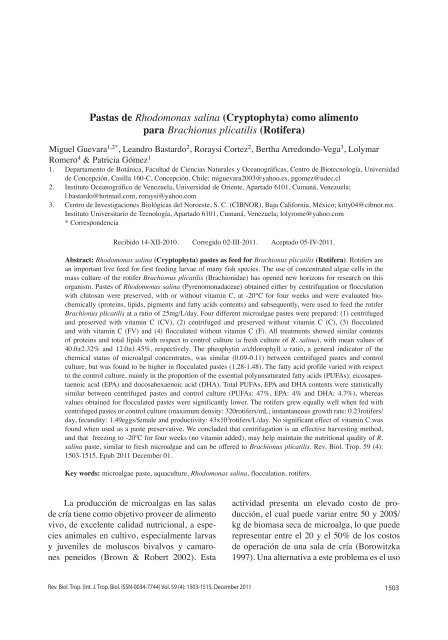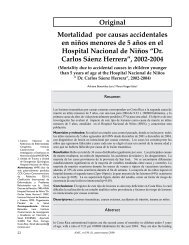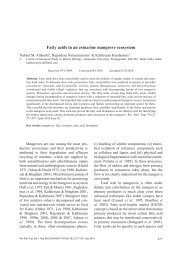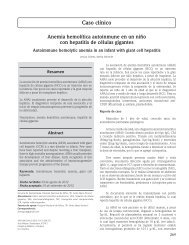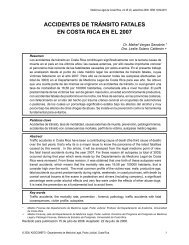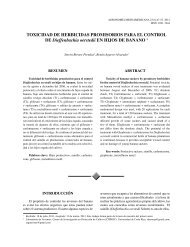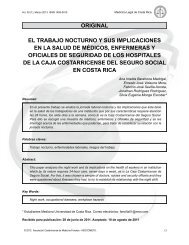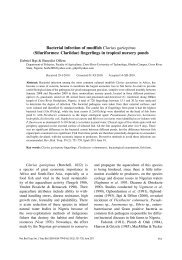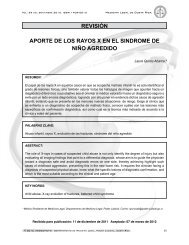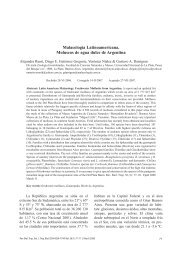Pastas de Rhodomonas salina (Cryptophyta) como alimento para ...
Pastas de Rhodomonas salina (Cryptophyta) como alimento para ...
Pastas de Rhodomonas salina (Cryptophyta) como alimento para ...
Create successful ePaper yourself
Turn your PDF publications into a flip-book with our unique Google optimized e-Paper software.
<strong>Pastas</strong> <strong>de</strong> <strong>Rhodomonas</strong> <strong>salina</strong> (<strong>Cryptophyta</strong>) <strong>como</strong> <strong>alimento</strong><br />
<strong>para</strong> Brachionus plicatilis (Rotifera)<br />
Miguel Guevara 1,2* , Leandro Bastardo 2 , Roraysi Cortez 2 , Bertha Arredondo-Vega 3 , Lolymar<br />
Romero 4 & Patricia Gómez 1<br />
1. Departamento <strong>de</strong> Botánica, Facultad <strong>de</strong> Ciencias Naturales y Oceanográficas, Centro <strong>de</strong> Biotecnología, Universidad<br />
<strong>de</strong> Concepción, Casilla 160-C, Concepción, Chile; miguevara2003@yahoo.es, pgomez@u<strong>de</strong>c.cl<br />
2. Instituto Oceanográfico <strong>de</strong> Venezuela, Universidad <strong>de</strong> Oriente, Apartado 6101, Cumaná, Venezuela;<br />
l.bastardo@hotmail.com, roraysi@yahoo.com<br />
3. Centro <strong>de</strong> Investigaciones Biológicas <strong>de</strong>l Noroeste, S. C. (CIBNOR), Baja California, México; kitty04@cibnor.mx<br />
Instituto Universitario <strong>de</strong> Tecnología, Apartado 6101, Cumaná, Venezuela; lolyrome@yahoo.com<br />
* Correspon<strong>de</strong>ncia<br />
Recibido 14-XII-2010. Corregido 02-III-2011. Aceptado 05-IV-2011.<br />
Abstract: <strong>Rhodomonas</strong> <strong>salina</strong> (<strong>Cryptophyta</strong>) pastes as feed for Brachionus plicatilis (Rotifera). Rotifers are<br />
an important live feed for first feeding larvae of many fish species. The use of concentrated algae cells in the<br />
mass culture of the rotifer Brachionus plicatilis (Brachionidae) has opened new horizons for research on this<br />
organism. Pastes of <strong>Rhodomonas</strong> <strong>salina</strong> (Pyrenomonadaceae) obtained either by centrifugation or flocculation<br />
with chitosan were preserved, with or without vitamin C, at -20°C for four weeks and were evaluated biochemically<br />
(proteins, lipids, pigments and fatty acids contents) and subsequently, were used to feed the rotifer<br />
Brachionus plicatilis at a ratio of 25mg/L/day. Four different microalgae pastes were prepared: (1) centrifuged<br />
and preserved with vitamin C (CV), (2) centrifuged and preserved without vitamin C (C), (3) flocculated<br />
and with vitamin C (FV) and (4) flocculated without vitamin C (F). All treatments showed similar contents<br />
of proteins and total lipids with respect to control culture (a fresh culture of R. <strong>salina</strong>), with mean values of<br />
40.0±2.32% and 12.0±1.45%, respectively. The pheophytin a/chlorophyll a ratio, a general indicator of the<br />
chemical status of microalgal concentrates, was similar (0.09-0.11) between centrifuged pastes and control<br />
culture, but was found to be higher in flocculated pastes (1.28-1.48). The fatty acid profile varied with respect<br />
to the control culture, mainly in the proportion of the essential polyunsaturated fatty acids (PUFAs): eicosapentaenoic<br />
acid (EPA) and docosahexaenoic acid (DHA). Total PUFAs, EPA and DHA contents were statistically<br />
similar between centrifuged pastes and control culture (PUFAs: 47%, EPA: 4% and DHA: 4.7%), whereas<br />
values obtained for flocculated pastes were significantly lower. The rotifers grew equally well when fed with<br />
centrifuged pastes or control culture (maximum <strong>de</strong>nsity: 320rotifers/mL; instantaneous growth rate: 0.23rotifers/<br />
day, fecundity: 1.49eggs/female and productivity: 43x10 3 rotifers/L/day. No significant effect of vitamin C was<br />
found when used as a paste preservative. We conclu<strong>de</strong>d that centrifugation is an effective harvesting method,<br />
and that freezing to -20ºC for four weeks (no vitamin ad<strong>de</strong>d), may help maintain the nutritional quality of R.<br />
<strong>salina</strong> paste, similar to fresh microalgae and can be offered to Brachionus plicatilis. Rev. Biol. Trop. 59 (4):<br />
1503-1515. Epub 2011 December 01.<br />
Key words: microalgae paste, aquaculture, <strong>Rhodomonas</strong> <strong>salina</strong>, flocculation, rotifers.<br />
La producción <strong>de</strong> microalgas en las salas<br />
<strong>de</strong> cría tiene <strong>como</strong> objetivo proveer <strong>de</strong> <strong>alimento</strong><br />
vivo, <strong>de</strong> excelente calidad nutricional, a especies<br />
animales en cultivo, especialmente larvas<br />
y juveniles <strong>de</strong> moluscos bivalvos y camarones<br />
peneidos (Brown & Robert 2002). Esta<br />
actividad presenta un elevado costo <strong>de</strong> producción,<br />
el cual pue<strong>de</strong> variar entre 50 y 200$/<br />
kg <strong>de</strong> biomasa seca <strong>de</strong> microalga, lo que pue<strong>de</strong><br />
representar entre el 20 y el 50% <strong>de</strong> los costos<br />
<strong>de</strong> operación <strong>de</strong> una sala <strong>de</strong> cría (Borowitzka<br />
1997). Una alternativa a este problema es el uso<br />
Rev. Biol. Trop. (Int. J. Trop. Biol. ISSN-0034-7744) Vol. 59 (4): 1503-1515, December 2011<br />
1503
<strong>de</strong> biomasa microalgal preservada en forma <strong>de</strong><br />
pastas, ya que ésta podría reducir los costos <strong>de</strong><br />
producción y, a<strong>de</strong>más, disminuir la <strong>de</strong>pen<strong>de</strong>ncia<br />
<strong>de</strong>l <strong>alimento</strong> vivo en los periodos don<strong>de</strong> las<br />
variaciones estacionales limitan su producción<br />
(Heasman et al. 2000).<br />
La centrifugación es el método más usado<br />
<strong>para</strong> obtener concentrados microalgales; mientras<br />
que la floculación, un método ampliamente<br />
usado en la industria <strong>para</strong> remover sólidos<br />
en suspensión, también ha sido exitosamente<br />
aplicado a la cosecha <strong>de</strong> biomasa microalgal<br />
(Molina-Grima et al. 2003). Los concentrados<br />
<strong>de</strong> microalgas producidos por centrifugación o<br />
floculación y mantenidos refrigerados entre 2<br />
y 4°C por una a ocho semanas, se han usado<br />
exitosamente en la alimentación <strong>de</strong> larvas y<br />
juveniles <strong>de</strong> bivalvos (Bonaldo et al. 2005).<br />
Nell & O’Connor (1991) encontraron que las<br />
larvas <strong>de</strong> Saccostrea glomerata mostraron un<br />
crecimiento equivalente al ser alimentadas con<br />
Pavlova lutheri e Isochrysis galbana, tanto en<br />
forma <strong>de</strong> dieta viva o <strong>como</strong> pasta. Resultados<br />
similares fueron obtenidos por Brown &<br />
Robert (2002) en larvas y jóvenes <strong>de</strong> Crassostrea<br />
gigas, alimentadas con pastas floculadas<br />
<strong>de</strong> Chaetoceros calcitrans. A pesar <strong>de</strong> que las<br />
pastas preservadas <strong>de</strong> microalgas constituyen<br />
un <strong>alimento</strong> <strong>de</strong> bajo costo (Conceição et al.<br />
2010), fácil obtención (Bonaldo et al. 2005) y<br />
transporte, hay que tener en consi<strong>de</strong>ración que<br />
la preservación en el tiempo <strong>de</strong> su calidad nutricional<br />
es específica-especie, dadas las variadas<br />
características morfo-estructurales <strong>de</strong> la pared<br />
celular <strong>de</strong> las microalgas (Ponis et al. 2008). Es<br />
así, por ejemplo, <strong>como</strong> los concentrados unialgales<br />
<strong>de</strong> Chaetoceros calcitrans, Skeletonema<br />
costatum y Tetraselmis spp. que se mantienen<br />
bajo refrigeración conservan su composición<br />
bioquímica hasta por un periodo <strong>de</strong> dos meses<br />
(Heasman et al. 2000); mientras que la biomasa<br />
<strong>de</strong> Isochrysis sp. (TISO) y Pavlova lutheri, se<br />
<strong>de</strong>teriora con mayor facilidad (Molina-Grima<br />
et al. 1994, McCausland et al. 1999). Entre los<br />
métodos utilizados <strong>para</strong> preservar la calidad<br />
nutricional <strong>de</strong> las pastas microalgales están:<br />
la aplicación <strong>de</strong> antioxidantes (Molina-Grima<br />
et al. 1994, Heasman et al. 2000, Tzovenis et<br />
al. 2004), control <strong>de</strong> luz (Montaini et al. 1995,<br />
Chini Zittelli et al. 2003), liofilización (Albentosa<br />
et al. 1997), temperatura (McCausland et<br />
al. 1999), aireación (Ponis et al. 2008), congelación<br />
(Lubzens et al. 1995) y refrigeración<br />
(Robert et al. 2001, Nunes et al. 2009).<br />
Las criptófitas han sido poco utilizadas<br />
<strong>para</strong> producir concentrados algales, a pesar <strong>de</strong><br />
su excelente calidad nutricional y facilidad <strong>de</strong><br />
cultivo (Renaud et al. 2002, Bermú<strong>de</strong>z et al.<br />
2004). <strong>Rhodomonas</strong> <strong>salina</strong> (Wislouch) Hill &<br />
Wetherbee (1989) es la criptófita que más se ha<br />
utilizado en acuicultura <strong>de</strong>bido, principalmente,<br />
a su alto contenido <strong>de</strong> proteínas, lípidos y<br />
ácidos grasos poliinsaturados (Fernán<strong>de</strong>z et al.<br />
1989, Zhukova & Aizdaicher 1995, Dunstan et<br />
al. 2005). Su valor nutricional explica su capacidad<br />
<strong>para</strong> incrementar la tasa <strong>de</strong> supervivencia<br />
<strong>de</strong>l pectínido Pecten maximus (Tremblay et al.<br />
2007) y la tasa <strong>de</strong> crecimiento instantánea <strong>de</strong><br />
juveniles <strong>de</strong> Crassostrea gigas (MCCausland<br />
et al. 1999). Por eso uno <strong>de</strong> los objetivos <strong>de</strong><br />
este estudio fue evaluar la composición bioquímica<br />
<strong>de</strong> pastas obtenidas a partir <strong>de</strong> una<br />
cepa <strong>de</strong> <strong>Rhodomonas</strong> <strong>salina</strong>, mediante el uso<br />
<strong>de</strong> distintos métodos <strong>de</strong> cosecha y preservación<br />
<strong>de</strong>l concentrado microalgal.<br />
El rotífero Brachionus plicatilis (Müller)<br />
es usado ampliamente en acuicultura <strong>como</strong><br />
vehículo <strong>para</strong> proporcionar nutrientes esenciales<br />
a especies animales en cultivo. Entre sus<br />
características <strong>de</strong>stacan su tamaño microscópico<br />
(130-300µm), movimiento lento en el agua,<br />
fácil y económica alimentación con diferentes<br />
especies <strong>de</strong> fitoplancton y/o levadura, a parte<br />
<strong>de</strong> su tasa alta <strong>de</strong> reproducción (James et al.<br />
1983). El cultivo <strong>de</strong> B. plicatilis data <strong>de</strong>s<strong>de</strong><br />
1960 y, a partir <strong>de</strong> esa fecha, se ha venido<br />
empleando en la larvicultura <strong>de</strong> diversas especies<br />
<strong>de</strong> peces (Theilacker & McMaster 1971,<br />
Opstad et al. 1985, Lubzens et al. 1989, Cavalin<br />
& Weirich 2009) y crustáceos (Liao et al.<br />
1983, Alvarez & Ewald 1990).<br />
Brachionus plicatilis ha sido alimentado<br />
exitosamente con diferentes microalgas, ya<br />
sea en forma fresca o <strong>como</strong> pasta congelada<br />
(Lubzens et al. 1995), polvo seco (Robert &<br />
Trintignac 1997) y polvo liofilizado (Yúfera<br />
1504 Rev. Biol. Trop. (Int. J. Trop. Biol. ISSN-0034-7744) Vol. 59 (4): 1503-1515, December 2011
& Navarro 1995, Navarro & Sarasquete 1998);<br />
siendo las pastas congeladas una <strong>de</strong> las mejores<br />
fuentes <strong>de</strong> nutrientes <strong>para</strong> estos organismos<br />
(Lubzens et al.1995, Gallagher et al. 2001). El<br />
uso <strong>de</strong> pastas <strong>de</strong> R. <strong>salina</strong> <strong>para</strong> la alimentación<br />
<strong>de</strong>l rotífero Brachionus plicatilis no está documentado,<br />
por lo cual esta investigación planteó<br />
la evaluación <strong>de</strong> este tipo pasta <strong>como</strong> <strong>alimento</strong><br />
<strong>de</strong> este importante microinvertebrado.<br />
MATERIALES Y MÉTODOS<br />
Cepa <strong>de</strong> microalga y <strong>de</strong>l rotífero: La cepa<br />
CS174 <strong>de</strong> <strong>Rhodomonas</strong> <strong>salina</strong> (Wislouch) Hill<br />
& Wetherbee (1989) fue obtenida <strong>de</strong>l Cepario<br />
CSIRO Algal Culture Collection, CSIRO Division<br />
of Marine Research, Hobart, Tasmania.<br />
La cepa <strong>de</strong> Brachionus plicatilis fue aislada <strong>de</strong><br />
las <strong>salina</strong>s <strong>de</strong> Araya, Venezuela (10º30’-10º40’’<br />
N - 63º32’-64º21’’ W). Ambos organismos<br />
están <strong>de</strong>positados en la colección <strong>de</strong> cultivos<br />
planctónicos <strong>de</strong>l Laboratorio <strong>de</strong> Acuicultura,<br />
extensión Plancton <strong>de</strong>l Departamento <strong>de</strong> Biología<br />
Pesquera, <strong>de</strong>l Instituto Oceanográfico <strong>de</strong><br />
Venezuela, Universidad <strong>de</strong> Oriente.<br />
Condiciones <strong>de</strong>l cultivo <strong>de</strong> la microalga:<br />
Un cultivo <strong>de</strong> R. <strong>salina</strong> en fase <strong>de</strong> crecimiento<br />
exponencial, aclimatado durante tres<br />
generaciones (K=0.9div/día) a luz continua<br />
(100µmol/m 2 /s <strong>de</strong> irradianza), 29±1ºC y pH<br />
entre 7.5-8.5 se usó <strong>para</strong> inocular 13L <strong>de</strong> medio<br />
fresco contenidos en botellones <strong>de</strong> vidrio <strong>de</strong><br />
15L, provistos <strong>de</strong> aireación constante (200mL/<br />
min). Estos nuevos cultivos se realizaron por<br />
cuadruplicado con una <strong>de</strong>nsidad inicial <strong>de</strong><br />
1x10 5 cel/mL, en medio f/2 (Guillard 1975)<br />
con una concentración <strong>de</strong> nitrato y fosfato <strong>de</strong><br />
3.5mM y 0.018mM, respectivamente, utilizando<br />
agua <strong>de</strong> mar (37UPS) filtrada y esterilizada<br />
en autoclave (15psi/120°C/15 min).<br />
Producción <strong>de</strong> pastas algales <strong>de</strong> <strong>Rhodomonas</strong><br />
<strong>salina</strong>: Cuando los cultivos alcanzaron<br />
la fase <strong>de</strong> crecimiento exponencial tardía (6to<br />
día), se procedió a realizar la cosecha total,<br />
<strong>para</strong> lo cual se evaluaron dos métodos: (a).-<br />
Centrifugación: consistió en centrifugar 6L<br />
<strong>de</strong> cultivo, <strong>de</strong> cada réplica, a 3 000rpm/5min,<br />
usando tubos cónicos <strong>de</strong> 15mL <strong>de</strong> capacidad.<br />
(b).- Floculación: se basó en agregar al cultivo<br />
(6L <strong>de</strong> cada réplica) una solución <strong>de</strong> quitosano<br />
en ácido acético (7.5g <strong>de</strong> quitosano/500mL <strong>de</strong><br />
ácido acético al 20%), al cual se le subió previamente<br />
el pH hasta 10 con NaOH 1mol/L. La<br />
adición <strong>de</strong> la solución <strong>de</strong> quitosano fue hasta<br />
que el pH se estabilizó entre 7 y 8. A continuación<br />
se agitó y <strong>de</strong>jó en reposo <strong>para</strong> propiciar la<br />
floculación (Morales et al. 1985).<br />
Las pastas algales (obtenidas por centrifugación<br />
y floculación) fueron divididas en dos<br />
partes cada una y a una <strong>de</strong> las partes se le agregó<br />
0.1% m/m <strong>de</strong> vitamina C (ácido ascórbico)<br />
con la finalidad <strong>de</strong> evaluar su utilidad <strong>como</strong><br />
antioxidante (Nunes et al. 2009). Posteriormente,<br />
todas las pastas fueron almacenadas durante<br />
cuatro semanas a -20ºC en oscuridad. De esta<br />
forma, quedaron constituidas cuatro tipos <strong>de</strong><br />
pastas algales: (1) centrifugada y con vitamina<br />
C (CV), (2) centrifugada y sin vitamina C (C),<br />
(3) floculada y con vitamina C (FV) y (4) floculada<br />
y sin adición <strong>de</strong> vitamina C (F).<br />
Después <strong>de</strong> cuatro semanas <strong>de</strong> almacenamiento,<br />
se pesó 1g <strong>de</strong> cada pasta microalgal y<br />
se resuspendió en 49mL <strong>de</strong> agua <strong>de</strong> mar filtrada<br />
y esterilizada. A partir <strong>de</strong> esta resuspensión se<br />
<strong>de</strong>terminó la concentración <strong>de</strong> proteínas totales<br />
(Lowry et al. 1951), lípidos totales (Marsh<br />
& Weinstein 1966), ácidos grasos (Sato &<br />
Murata 1988), clorofila a, feofitina a y relación<br />
feofitina a/clorofila a (Lorenzen 1967). Los<br />
cultivos frescos <strong>de</strong> R. <strong>salina</strong>, se realizaron por<br />
cuadruplicado en similares condiciones, fueron<br />
analizados bioquímicamente y se usaron<br />
<strong>como</strong> controles.<br />
Ensayos <strong>de</strong> alimentación <strong>de</strong>l rotífero B.<br />
plicatilis con pastas algales: Los cultivos <strong>de</strong><br />
B. plicatilis se realizaron, por cuadruplicado,<br />
en matraces <strong>de</strong> 500ml <strong>de</strong> capacidad con 250ml<br />
<strong>de</strong> agua <strong>de</strong> mar (37UPS) filtrada a través <strong>de</strong> una<br />
batería <strong>de</strong> filtros: 10; 5; 1; 0.1µm y esterilizada<br />
mediante tratamiento con luz UV. Los cultivos<br />
se iniciaron con una <strong>de</strong>nsidad <strong>de</strong> 100rotíferos/<br />
mL y se mantuvieron con aireación continua<br />
(50mL/min). Diariamente, se les proporcionó,<br />
Rev. Biol. Trop. (Int. J. Trop. Biol. ISSN-0034-7744) Vol. 59 (4): 1503-1515, December 2011<br />
1505
por se<strong>para</strong>do, 25mg/L <strong>de</strong> cada pasta <strong>de</strong> R. <strong>salina</strong>,<br />
previamente resuspendidas en agua <strong>de</strong> mar<br />
(Navarro & Yúfera (1998). Paralelamente, en<br />
similares condiciones, se realizaron cultivos <strong>de</strong><br />
B. plicatilis y se alimentaron con cultivos frescos<br />
<strong>de</strong> <strong>Rhodomonas</strong> <strong>salina</strong> (ración equivalente<br />
a 25mg/L/día).<br />
Diariamente, se <strong>de</strong>terminó la <strong>de</strong>nsidad <strong>de</strong><br />
rotíferos. Cuando los cultivos mostraron sus<br />
mayores valores <strong>de</strong> <strong>de</strong>nsidad poblacional se<br />
procedió a calcular la tasa instantánea <strong>de</strong> crecimiento,<br />
la fecundidad (número <strong>de</strong> huevos/hembra)<br />
y productividad (rotíferos/L/día) según<br />
Navarro & Yúfera (1998).<br />
Los resultados <strong>de</strong> las evaluaciones bioquímicas<br />
<strong>de</strong> las pastas microalgales, así <strong>como</strong> los<br />
datos <strong>de</strong> crecimiento, productividad y fecundidad<br />
<strong>de</strong> los rotíferos se com<strong>para</strong>ron mediante<br />
análisis <strong>de</strong> varianza (ANOVA) <strong>de</strong> una vía,<br />
utilizando el programa estadístico Statistix<br />
V.1.0, previo cumplimiento <strong>de</strong> los supuestos<br />
<strong>de</strong>: normalidad <strong>de</strong>l error (prueba <strong>de</strong> Wilk-Sahpiro),<br />
homogeneidad <strong>de</strong> las varianzas (prueba<br />
<strong>de</strong> Bartlett) y aditividad <strong>de</strong> los efectos (prueba<br />
<strong>de</strong> Tukey). Los datos que mostraron diferencias<br />
significativas (p0.05) ni entre ellas ni con respecto<br />
al cultivo fresco (Fig. 1). Los valores promedio<br />
(media±<strong>de</strong>sviación estándar) <strong>para</strong> estos<br />
parámetros fueron 40.0±2.3% <strong>de</strong> proteínas y<br />
12.0±1.4% <strong>de</strong> lípidos.<br />
50<br />
45<br />
a<br />
a<br />
a<br />
a<br />
a<br />
40<br />
% con base a masa seca<br />
35<br />
30<br />
25<br />
20<br />
15<br />
b<br />
b<br />
b<br />
b<br />
b<br />
10<br />
5<br />
0<br />
Control CV C FV F<br />
<strong>Pastas</strong><br />
Fig. 1. Contenido (%) <strong>de</strong> proteínas y lípidos totales <strong>de</strong> las pastas <strong>de</strong> <strong>Rhodomonas</strong> <strong>salina</strong>. Proteínas totales, Lípidos<br />
totales. CV: centrifugada con vitamina C, C: centrifugada sin vitamina C. FV: floculada y con adición <strong>de</strong> vitamina C,<br />
F: floculada y sin adición <strong>de</strong> vitamina C. Control: cultivo fresco <strong>de</strong> R. <strong>salina</strong>. Letras comunes (a,b) indican grupos<br />
estadísticamente homogéneos (Dunnet, p>0.05).<br />
Fig. 1. Total protein and lipid contents (%) of pastes of <strong>Rhodomonas</strong> <strong>salina</strong>. Total proteins, Total lipids. CV: centrifuged<br />
and preserved with vitamin C, C: centrifuged and preserved without vitamin C. FV: flocculated and preserved with vitamin<br />
C and F: flocculated and without addition of vitamin C. Control: fresh culture of R. <strong>salina</strong>. Common letters (a,b) indicate<br />
statistically homogeneous groups (Dunnet, p>0.05).<br />
1506 Rev. Biol. Trop. (Int. J. Trop. Biol. ISSN-0034-7744) Vol. 59 (4): 1503-1515, December 2011
Perfil <strong>de</strong> ácidos grasos: El perfil <strong>de</strong> ácidos<br />
grasos <strong>de</strong> las cuatro pastas <strong>de</strong> R. <strong>salina</strong> (FV,<br />
F, CV y C), almacenadas durante cuatro semanas<br />
a -20°C presentó pocas variaciones con<br />
respecto al control (cultivo fresco) (Cuadro 1).<br />
Las mayores variaciones se observaron en el<br />
contenido total <strong>de</strong> los ácidos grasos poliinsaturados<br />
(PUFAs), los cuales mostraron diferencias<br />
significativas entre las diferentes pastas<br />
(Dunnet, p0.05). *=Promedio±<strong>de</strong>sviación estándar.<br />
Rev. Biol. Trop. (Int. J. Trop. Biol. ISSN-0034-7744) Vol. 59 (4): 1503-1515, December 2011<br />
1507
Las pastas centrifugadas (CV y C) presentaron<br />
porcentajes <strong>de</strong> PUFAs totales similares al<br />
control (47%), valor que fue significativamente<br />
superior (Dunnet, p0.05) con<br />
Relación feotitina a/clorofila a<br />
1.8<br />
1.6<br />
1.4<br />
1.2<br />
1<br />
0.8<br />
0.6<br />
0.4<br />
b<br />
b<br />
0.2<br />
0<br />
a a a<br />
Control CV C FV F<br />
<strong>Pastas</strong><br />
Fig. 2. Relación feofitina a/clorofila a <strong>de</strong> las pastas <strong>de</strong> <strong>Rhodomonas</strong> <strong>salina</strong>. Abreviaturas <strong>como</strong> en la Fig. 1. Letras comunes<br />
(a,b) indican grupos estadísticamente homogéneos (Dunnet, p>0.05).<br />
Fig. 2. Pheophytin a/chlorophyll a relation of pastes of <strong>Rhodomonas</strong> <strong>salina</strong>. Abbreviations as in Fig. 1. Common letters (a,b)<br />
indicate statistically homogeneous groups (Dunnet, p>0.05).<br />
1508 Rev. Biol. Trop. (Int. J. Trop. Biol. ISSN-0034-7744) Vol. 59 (4): 1503-1515, December 2011
400<br />
300<br />
Control<br />
C<br />
CV<br />
a<br />
a<br />
a<br />
Rotíferos/mL<br />
200<br />
FV<br />
100<br />
F<br />
b<br />
b<br />
0<br />
0 1 2 3 4 5 6<br />
Días<br />
Fig. 3. Crecimiento (rotíferos/mL) <strong>de</strong>l rotífero Brachionus plicatilis alimentado con las diferentes pastas <strong>de</strong> <strong>Rhodomonas</strong><br />
<strong>salina</strong>. Abreviaturas <strong>como</strong> en la Fig. 1. Letras comunes (a,b) indican grupos estadísticamente homogéneos (Dunnet, p>0.05).<br />
Fig. 3. Growth (rotifers/mL) of the rotifer Brachionus plicatilis fed with different pastes of <strong>Rhodomonas</strong> <strong>salina</strong>.<br />
Abbreviations as in Fig. 1. Common letters (a,b) indicate statistically homogeneous groups (Dunnet, p>0.05).<br />
CUADRO 2<br />
Crecimiento y fecundidad <strong>de</strong> B. plicatilis alimentado con diferentes pastas <strong>de</strong> <strong>Rhodomonas</strong> <strong>salina</strong><br />
TABLE 2<br />
Growth and fecundity of B. plicatilis fed different pastes of <strong>Rhodomonas</strong> <strong>salina</strong><br />
Densidad máxima<br />
(rotíferos/mL)*<br />
Tasa instantánea <strong>de</strong><br />
crecimiento<br />
(rotíferos/día)*<br />
Productividad<br />
(rotíferos/L/día)*<br />
Fecundidad<br />
(huevos/hembra)*<br />
Control 320.5 ± 26.24 a 0.23 ± 0.016 a 40.59 x 10 3 ± 3039 a 1.50 ± 0.09 a<br />
CV 325.6 ± 23.40 a 0.24 ± 0.014 a 45.12 x 10 3 ± 4680 a 1.46 ± 0.10 a<br />
C 315.7 ± 20.47 a 0.23 ± 0.013 a 43.14 x 10 3 ± 4094 a 1.52 ± 0.06 a<br />
FV 210.4 ± 12.18 b 0.15 ± 0.012 b 22.08 x 10 3 ± 2436 0.80 ± 0.04 b<br />
F 212.4 ± 17.80 b 0.15 ± 0.017 b 22.48 x 10 3 ± 3560 0.86 ± 0.05 b<br />
Abreviaturas <strong>como</strong> en la Fig. 1. Letras comunes (a,b) en una misma columna indican grupos estadísticamente homogéneos<br />
(Dunnet, p>0.05). *=Promedio±<strong>de</strong>sviación estándar.<br />
respecto a los parámetros <strong>de</strong> los individuos<br />
cultivados con el <strong>alimento</strong> control (cultivo<br />
fresco). Por otro lado, los rotíferos alimentados<br />
con las pastas obtenidas por floculación (FV<br />
y F) mostraron parámetros <strong>de</strong> crecimiento y<br />
fecundidad significativamente inferiores (Dunnet,<br />
p
marinas en cultivo (Lubzens et al. 2001). La<br />
centrifugación o floculación no afectó la composición<br />
<strong>de</strong> proteínas y lípidos <strong>de</strong> las pastas, así<br />
<strong>como</strong> tampoco las afectó el almacenamiento a<br />
-20ºC por 4 semanas.<br />
Por otro lado, las pastas obtenidas por<br />
centrifugación conservaron la proporción <strong>de</strong><br />
PUFAs esenciales, EPA y DHA similares al cultivo<br />
fresco y produjeron mayor crecimiento y<br />
fecundidad <strong>de</strong> B. plicatilis, que las pastas obtenidas<br />
por floculación con quitosano (Cuadro<br />
1, 2, Fig. 3). Este último hallazgo respalda un<br />
hecho que ha sido previamente <strong>de</strong>stacado <strong>para</strong><br />
numerosas especies (Levine & Sulkin 1984,<br />
Pernet & Tremblay 2004): la importancia <strong>de</strong> los<br />
PUFAs <strong>como</strong> nutrientes esenciales, y convierte<br />
la diferencia <strong>de</strong>l método <strong>de</strong> concentración <strong>de</strong><br />
microalgas en un hecho muy relevante.<br />
A<strong>de</strong>más, las pastas obtenidas por centrifugación<br />
mostraron una mayor estabilidad<br />
bioquímica que las obtenidas por floculación,<br />
tal <strong>como</strong> se evi<strong>de</strong>ncia en sus perfiles <strong>de</strong> ácidos<br />
grasos (Cuadro 1) y en su baja relación feofitina<br />
a/clorofila a (Fig. 2). Este comportamiento<br />
se <strong>de</strong>bería a que las células sufren menor daño<br />
físico al ser centrifugadas, resultado que se<br />
respalda en las investigaciones <strong>de</strong> Beneman et<br />
al. (1980), Montaini et al. (1995), Albentosa et<br />
al. (1997), D`Souza et al. (2000), Heasman et<br />
al. (2000), Molina-Grima et al. (2003) y Nunes<br />
et al. (2009), quienes coinci<strong>de</strong>n en las ventajas<br />
com<strong>para</strong>tivas <strong>de</strong> este método <strong>de</strong> cosecha.<br />
Algunos autores han indicado que la estabilidad<br />
bioquímica, así <strong>como</strong> la viabilidad celular<br />
<strong>de</strong> las pastas <strong>de</strong> microalgas pue<strong>de</strong> mejorarse<br />
a través <strong>de</strong>l uso <strong>de</strong> aditivos, tipo antioxidantes.<br />
Heasman et al. (2000) señalaron que las pastas<br />
<strong>de</strong> Skeletonema con adición <strong>de</strong> vitamina<br />
C <strong>como</strong> antioxidante, mantienen una calidad<br />
nutricional superior a aquellas que carecen <strong>de</strong><br />
este aditivo; sin embargo, en nuestro estudio<br />
las pastas que contenían vitamina C no mostraron<br />
diferencias significativas, en cuanto a<br />
su composición bioquímica, con respecto a las<br />
que no contenían este aditivo. Resultados similares<br />
fueron obtenidos por Robert et al. (2001),<br />
quienes encontraron que las pastas <strong>de</strong> Tetraselmis<br />
suecica, obtenidas por centrifugación<br />
y almacenadas sin vitamina C, a 4°C, durante<br />
cinco semanas, mantuvieron estable su perfil<br />
<strong>de</strong> ácidos grasos y su contenido <strong>de</strong> lípidos y<br />
proteínas. De igual forma, Ponis et al. (2003b)<br />
<strong>de</strong>mostraron que pastas <strong>de</strong> Pavlova lutheri preservadas<br />
a 1 y 4°C, sin vitamina C, mantienen<br />
inalterable su valor nutricional durante 27 días.<br />
Esta concordancia <strong>de</strong> resultados permite concluir<br />
que la baja temperatura sería suficiente<br />
<strong>para</strong> mantener la calidad nutricional <strong>de</strong> los concentrados<br />
<strong>de</strong> microalgas, no siendo necesaria la<br />
adición <strong>de</strong> preservantes en muchos casos.<br />
A pesar <strong>de</strong> las ventajas <strong>de</strong> la centrifugación<br />
<strong>para</strong> generar concentrados <strong>de</strong> microalgas,<br />
ésta presenta el inconveniente <strong>de</strong> ser costosa<br />
y poco práctica cuando se trabaja con gran<strong>de</strong>s<br />
volúmenes <strong>de</strong> cultivo (Knuckey et al. 2006).<br />
Lo anterior ha motivado el uso <strong>de</strong> floculantes<br />
<strong>como</strong> un método <strong>de</strong> cosecha más económico<br />
y a<strong>de</strong>cuado <strong>para</strong> tratar gran<strong>de</strong>s volúmenes <strong>de</strong><br />
cultivo; sin embargo, se ha planteado que las<br />
pastas floculadas suelen sufrir mayor <strong>de</strong>terioro<br />
que las centrifugadas <strong>de</strong>bido, principalmente,<br />
a que los cambios en el pH y el <strong>de</strong>sequilibrio<br />
<strong>de</strong>l potencial iónico, producido durante el<br />
proceso <strong>de</strong> floculación, pue<strong>de</strong>n inducir estrés<br />
químico en las células <strong>de</strong> microalgas; lo cual,<br />
sin embargo, <strong>de</strong>pen<strong>de</strong>rá <strong>de</strong> la naturaleza <strong>de</strong> la<br />
pared celular <strong>de</strong> la especie floculada (Brown &<br />
Robert 2002).<br />
En el presente trabajo se observó que tanto<br />
las pastas floculadas con quitosano <strong>como</strong> las<br />
centrifugadas mantuvieron estable su contenido<br />
<strong>de</strong> proteínas y lípidos, durante el periodo<br />
<strong>de</strong> almacenamiento; no obstante, en las pastas<br />
floculadas, el contenido <strong>de</strong> clorofila a se vio<br />
negativamente afectado, con un concomitante<br />
incremento en su producto <strong>de</strong> <strong>de</strong>gradación:<br />
feofitina a. Ponis et al. (2003a) obtuvieron<br />
resultados similares con las biomasas floculadas<br />
<strong>de</strong> Chaetoceros calcitrans y Pavlova<br />
lutheri, las cuales mantuvieron estable su contenido<br />
proteico y lipídico, durante tres semanas<br />
<strong>de</strong> almacenamiento a 1°C, a pesar <strong>de</strong> haber<br />
experimentado un incremento <strong>de</strong> la relación<br />
feofitina a/clorofila a.<br />
La estabilidad <strong>de</strong>l perfil <strong>de</strong> ácidos grasos<br />
obtenida en esta investigación en las pastas<br />
1510 Rev. Biol. Trop. (Int. J. Trop. Biol. ISSN-0034-7744) Vol. 59 (4): 1503-1515, December 2011
centrifugadas <strong>de</strong> <strong>Rhodomonas</strong> <strong>salina</strong>, luego <strong>de</strong>l<br />
proceso <strong>de</strong> almacenamiento, ha sido previamente<br />
observada en otras especies <strong>de</strong> microalgas<br />
<strong>como</strong> Tetraselmis suecica e Isochrysis<br />
galbana, cuyas pastas han mantenido estable<br />
su perfil <strong>de</strong> ácidos grasos cuando se preservan a<br />
bajas temperaturas (Molina-Grima et al. 1994,<br />
Montaini et al. 1995).<br />
Los resultados <strong>de</strong> esta investigación indican<br />
que la biomasa centrifugada y congelada<br />
<strong>de</strong> R. <strong>salina</strong> pue<strong>de</strong> ser usada <strong>como</strong> <strong>alimento</strong><br />
<strong>de</strong>l rotífero Brachionus plicatilis. Al com<strong>para</strong>r<br />
la máxima <strong>de</strong>nsidad <strong>de</strong> rotíferos (325.6rotíferos/mL)<br />
obtenida con las pastas microalgales<br />
centrifugadas se observa que ésta es superior<br />
a las reportadas por Hung (1988) y Guevara et<br />
al. (1996), y similar a las obtenidas por Gómez<br />
& Gómez (1997) quienes utilizaron levadura <strong>de</strong><br />
panificación <strong>como</strong> <strong>alimento</strong>, y obtuvieron <strong>de</strong>nsida<strong>de</strong>s<br />
<strong>de</strong> 60, 218 y 336rotíferos/mL, respectivamente.<br />
De igual forma, nuestros resultados<br />
superan a los valores obtenidos por Romero &<br />
Otero (2004) (214rotíferos/ml) y Romero et<br />
al. (2006) (250rotíferos/mL), cuando alimentaron<br />
a B. plicatilis con pastas <strong>de</strong> Chlorella<br />
centrifugada y mantenida a 4ºC. Los sistemas<br />
<strong>de</strong> cultivos más tecnificados, que incluyen<br />
alimentación continua con pasta <strong>de</strong> Nannochloropsis<br />
sp., han permitido obtener mayores<br />
<strong>de</strong>nsida<strong>de</strong>s <strong>de</strong> rotíferos (500-1 500Rotíferos/L)<br />
(Pfeiffer & Ludwig 2002). La máxima productividad<br />
<strong>de</strong> rotíferos obtenida en este trabajo<br />
(45.15x10 3 rotíferos/L/día) con las pastas centrifugadas<br />
es similar a la lograda por Gómez<br />
& Gómez (1997) cuando alimentaron a B. plicatilis<br />
con levadura <strong>de</strong> panificación y superior<br />
a las obtenidas por Navarro & Yúfera (1998)<br />
y Romero et al. (2006) cuando usaron <strong>como</strong><br />
<strong>alimento</strong> pasta <strong>de</strong> Chlorella y polvo liofilizado<br />
<strong>de</strong> Nannochloropsis oculata, respectivamente.<br />
Otro criterio <strong>de</strong> mucha importancia en la<br />
evaluación <strong>de</strong> los cultivos <strong>de</strong> rotíferos es la<br />
fecundidad, estimada a partir <strong>de</strong> la relación huevos/hembra,<br />
ya que permite visualizar el estado<br />
fisiológico <strong>de</strong> la población en un momento<br />
dado. En esta investigación, la máxima fecundidad<br />
se obtuvo con las pastas microalgales<br />
centrifugadas (1.5huevos/hembra). Esta<br />
fecundidad es superior a las obtenidas por<br />
Rueda (1996) (0.6-1.05huevos/hembra) con las<br />
microalgas Nannochloris sp., Nannochloropsis<br />
sp., Chlorella sp. y polvo <strong>de</strong> Spirulina sp.; y<br />
superan también los valores reportados por<br />
Romero et al. (2006), cuando alimentaron a B.<br />
plicatilis con pasta <strong>de</strong> Chlorella centrifugada,<br />
obteniendo 1 a 1.2huevos/hembra.<br />
A pesar <strong>de</strong> que en esta investigación no se<br />
analizó la composición bioquímica <strong>de</strong>l rotífero<br />
B. plicatilis, se pue<strong>de</strong> inferir que éstos <strong>de</strong>bieran<br />
presentar una composición bioquímica a<strong>de</strong>cuada,<br />
dado que muchos estudios han <strong>de</strong>mostrado<br />
que la calidad nutricional <strong>de</strong> este organismo<br />
<strong>de</strong>pen<strong>de</strong> <strong>de</strong> la composición bioquímica <strong>de</strong> la<br />
microalga utilizada <strong>para</strong> su alimentación (Lubzens<br />
et al. 1995, Dhert et al. 2001). Recientemente,<br />
Seychelles et al. (2009) evi<strong>de</strong>nciaron<br />
que el perfil <strong>de</strong> los ácidos grasos <strong>de</strong> los rotíferos<br />
fue similar al <strong>de</strong> las microalgas usadas<br />
<strong>para</strong> su alimentación (microalgas frescas o en<br />
forma <strong>de</strong> pasta).<br />
Las pastas centrifugadas <strong>de</strong> R. <strong>salina</strong><br />
caracterizadas en este estudio, también podrían<br />
utilizarse, directamente, <strong>como</strong> <strong>alimento</strong> <strong>de</strong> larvas<br />
y juveniles <strong>de</strong> moluscos bivalvos, <strong>de</strong>bido<br />
a su composición bioquímica, específicamente<br />
su perfil <strong>de</strong> ácidos grasos. Numerosos estudios<br />
han <strong>de</strong>mostrado que las microalgas con altos<br />
contenidos <strong>de</strong> EPA y DHA favorecen el crecimiento<br />
<strong>de</strong> juveniles <strong>de</strong> Ostrea edulis (Enright<br />
et al. 1986) y larvas <strong>de</strong> Patinopecten yessoensis<br />
(Whyte et al. 1989). De igual forma, Nell &<br />
O’Connor (1991) encontraron que las pastas<br />
<strong>de</strong> Pavlova lutheri y Chaetoceros calcitrans<br />
refrigeradas a 4ºC por una o dos semanas<br />
produjeron mayor crecimiento larvario <strong>de</strong> la<br />
ostra Saccostrea commercialis que el obtenido<br />
con las microalgas frescas. McCausland et al.<br />
(1999) lograron incrementar hasta en un 87%<br />
el crecimiento <strong>de</strong> juveniles <strong>de</strong> Crassostrea<br />
gigas al alimentarlas con pasta <strong>de</strong> Skeletonema<br />
costatum, cosechada mediante centrifugación y<br />
almacenada a 4ºC. Cabe <strong>de</strong>stacar que el DHA<br />
es, en general, un ácido graso escaso en las<br />
microalgas, por lo que su contenido relativamente<br />
alto en R. <strong>salina</strong> (Cuadro 1) la <strong>de</strong>staca<br />
Rev. Biol. Trop. (Int. J. Trop. Biol. ISSN-0034-7744) Vol. 59 (4): 1503-1515, December 2011<br />
1511
<strong>como</strong> una especie <strong>de</strong> especial valor nutricional<br />
<strong>para</strong> la acuicultura.<br />
A<strong>de</strong>más <strong>de</strong> las ventajas ya mencionadas <strong>de</strong><br />
utilizar pastas <strong>de</strong> microalgas <strong>como</strong> <strong>alimento</strong> en<br />
acuicultura, se ha planteado que su uso podría<br />
ser incluso más beneficioso <strong>para</strong> la salud <strong>de</strong> los<br />
animales que el uso <strong>de</strong> caldos <strong>de</strong> microalgas,<br />
ya que el medio <strong>de</strong> cultivo <strong>de</strong> las microalgas<br />
pue<strong>de</strong> contener toxinas y abundantes bacterias,<br />
las que pue<strong>de</strong>n inhibir el crecimiento <strong>de</strong> diferentes<br />
organismos animales en cultivo (DeMott<br />
et al. 1991, Kiviranta et al. 1991, O´Connor et<br />
al. 1992, Lee & Shen 2004, Sun et al. 2008).<br />
Finalmente, se concluye que la centrifugación,<br />
<strong>como</strong> método <strong>de</strong> cosecha, y la congelación<br />
a -20ºC, durante cuatro semanas, sin<br />
adición <strong>de</strong> vitamina C, permiten mantener la<br />
calidad nutricional <strong>de</strong> la pasta <strong>de</strong> R. <strong>salina</strong><br />
similar a la <strong>de</strong>l alga fresca y pue<strong>de</strong> ser utilizada<br />
<strong>como</strong> <strong>alimento</strong> <strong>para</strong> Brachionus plicatilis.<br />
AGRADECIMIENTOS<br />
Este trabajo fue financiado por la Universidad<br />
<strong>de</strong> Concepción, Chile a través <strong>de</strong>l proyecto<br />
DIUC Nº 208.111.050-1.0 y por el Consejo<br />
<strong>de</strong> Investigación <strong>de</strong> la Universidad <strong>de</strong> Oriente,<br />
Venezuela (proyecto CI.-2-030603-1282/06).<br />
Se agra<strong>de</strong>ce el apoyo brindado <strong>para</strong> los análisis<br />
<strong>de</strong> los ácidos grasos a los profesionales: Elena<br />
Palacios, Olivia Arjona y Laura Correón <strong>de</strong>l<br />
CIBNOR, México.<br />
RESUMEN<br />
<strong>Pastas</strong> <strong>de</strong> <strong>Rhodomonas</strong> <strong>salina</strong>, obtenidas mediante<br />
centrifugación y floculación con quitosano y preservadas<br />
con o sin vitamina C, a -20°C fueron evaluadas bioquímicamente<br />
y proporcionadas <strong>como</strong> <strong>alimento</strong> al rotífero Brachionus<br />
plicatilis. Las pastas microalgales: (1) centrifugada<br />
y con vitamina C (CV), (2) centrifugada y sin vitamina C<br />
(C), (3) floculada y con vitamina C (FV) y (4) floculada y<br />
sin adición <strong>de</strong> vitamina C (F); mantuvieron sus contenidos<br />
<strong>de</strong> proteínas y lípidos totales similares al cultivo control,<br />
con valores <strong>de</strong> 40.0±2.32% y 12.0±1.45%, respectivamente.<br />
La relación feofitina a/clorofila a fue similar (0.09-0.11)<br />
entre las pastas centrifugadas y el cultivo control, pero<br />
mayor en las pastas floculadas (1.28-1.48). Las pastas centrifugadas<br />
presentaron porcentajes <strong>de</strong> PUFAs totales, EPA<br />
y DHA similares al cultivo control (PUFAs: 47%, EPA:<br />
4% y DHA: 4.7%) y superiores al <strong>de</strong> las pastas floculadas.<br />
Las pastas obtenidas por centrifugación indujeron un crecimiento<br />
<strong>de</strong>l rotífero igual al obtenido con el <strong>alimento</strong> control<br />
(<strong>de</strong>nsidad máxima: 320rotíferos/mL; tasa instantánea<br />
<strong>de</strong> crecimiento: 0.23rotíferos/día, fecundidad: 1.49huevos/<br />
hembra y productividad: 43x10 3 rotíferos/L/día). Se concluye<br />
que la pasta <strong>de</strong> R. <strong>salina</strong> centrifugada y congelada a<br />
-20°C, durante cuatro semanas, sin adición <strong>de</strong> vitamina C,<br />
mantiene su calidad nutricional similar a la <strong>de</strong>l alga fresca<br />
y pue<strong>de</strong> ser usada <strong>como</strong> <strong>alimento</strong> <strong>de</strong> Brachionus plicatilis.<br />
Palabras clave: pasta <strong>de</strong> microalgas, acuicultura, <strong>Rhodomonas</strong><br />
<strong>salina</strong>, floculación, rotíferos.<br />
REFERENCIAS<br />
Albentosa, M., A. Pérez-Camacho, U. Labarta & M.J.<br />
Fernán<strong>de</strong>z-Reiriz. 1997. Evaluation of freeze-dried<br />
microalgal diets for the seed culture of Ruditapes<br />
<strong>de</strong>cussatus using physiological and biochemical <strong>para</strong>meters.<br />
Aquaculture 154: 305-321.<br />
Alvarez, Z. & J. Ewald. 1990. Efectos <strong>de</strong> la salinidad y la<br />
dieta sobre el <strong>de</strong>sarrollo larvario <strong>de</strong> Sesarma ricordi<br />
(Milne Edwards, 1853) (Decapoda, Grapsi<strong>de</strong>). Scient.<br />
Mar. 54: 55-60.<br />
Beneman, J., B. Koopman, D. Eisenberg & R. Goebel.<br />
1980. Development of micro-algae harvesting and<br />
high rate pond technologies in California, p. 457-<br />
495. In G. Shelef & C. Soe<strong>de</strong>r (eds.). Algae biomass.<br />
Elsevier/North Holland Biomedical, Amsterdam,<br />
Holanda.<br />
Bermú<strong>de</strong>z, J., N. Rosales, C. Loreto, B. Briceño & E.<br />
Morales. 2004. Exopolysacchari<strong>de</strong>, pigment and protein<br />
production by the marine microalga Chroomonas<br />
sp. in semicontinuos cultures. World. J. Microbiol.<br />
Biotechnol. 20: 179-183.<br />
Bonaldo, A., A. Badiani, S. Testi, G. Corso, A.L. Mor<strong>de</strong>nti<br />
& P.P. Gatta. 2005. Use of centrifuged and preserved<br />
microalgae from feeding juvenile Manila clam (Tapes<br />
philippinarum): effects on growth and fatty acid composition.<br />
Ital. J. Anim. Sci. 4: 375-384.<br />
Borowitzka, M. 1997. Microalgae for aquaculture: opportunities<br />
and constraints. J. Appl. Phycol. 9: 393-401.<br />
Brown, M. & R. Robert. 2002. Pre<strong>para</strong>tion and assessment<br />
of microalgal concentrates as feeds for larval and<br />
juvenile Pacific oyster (Crassostrea gigas). Aquaculture<br />
207: 289-309.<br />
Cavalin, F. & C. Weirich. 2009. Larval performance<br />
of aquacultured Florida pompano (Trachinotus<br />
1512 Rev. Biol. Trop. (Int. J. Trop. Biol. ISSN-0034-7744) Vol. 59 (4): 1503-1515, December 2011
carolinus) fed rotifers (Brachionus plicatilis) enriched<br />
with selected commercial diets. Aquaculture<br />
292: 67-73.<br />
Chini Zittelli, G., L. Rodolfi & M.R. Tredici. 2003. Mass<br />
cultivation of Nannochloropsis sp. in annular reactors.<br />
J. Appl. Phycol. 15: 107-114.<br />
Conceição, L., M. Yúfera, P. Makridis, S. Morais & M.<br />
Dinis. 2010. Live feeds for early stages of fish rearing.<br />
Aquaculture Res. 41: 613-640.<br />
DeMott, W., Q.X. Zhang & W.W. Carmichael. 1991.<br />
Effects of toxic cyanobacteria and purified toxins on<br />
the survival and feeding of a copepod and three species<br />
of Daphnia. Limnol. Oceanogr. 36: 1346-1457.<br />
Dhert, P., G. Rombaut, G. Suantika & P. Sorgeloos. 2001.<br />
Advancement of rotifer culture and manipulation<br />
techniques in Europe. Aquaculture 200: 129-146.<br />
D`Souza, F., D. Lecossois, M. Heasman, J. Diemar, C.<br />
Jackson & R. Pendrey. 2000. Evaluation of centrifuged<br />
microalgae concentrates as diets for Penaeus<br />
monodon (Fabricius) larvae. Aquaculture Res. 31:<br />
661-670.<br />
Dunstan, G., M. Brown & J. Volkman. 2005. Cryptophyceae<br />
and rhodophyceae: chemotaxonomy, phylogeny,<br />
and application. Phytochemistry 66: 2557-2570.<br />
Enright, C., G.F. Newkirk, J.S. Craigie & J.D. Castell.<br />
1986. Growth of juvenile Ostrea edulis L. fed Chaetoceros<br />
gracilis Schütt of varied chemical composition.<br />
J. Exp. Mar. Biol. Ecol. 96: 15-26.<br />
Fernán<strong>de</strong>z, M., A. Pérez, M. Ferreiro, J. Blanco, M. Planas,<br />
M.J. Campos & U. Labarta. 1989. Biomass production<br />
and variation on the biochemical profile (total<br />
proteins, carbohydrates, RNA, lipids and fatty acids)<br />
of seven species of marine microalgae. Aquaculture<br />
83: 17-37.<br />
Gallagher, M., H. Daniels & J. Harcke. 2001. Influence of<br />
the enrichment time with algae paste preservations<br />
on the fatty acid content of rotifers. W. Aquacult.<br />
32: 59-65.<br />
Gómez, O. & A. Gómez. 1997. Cultivo masivo <strong>de</strong>l rotífero<br />
Brachionus plicatilis (Muller, 1786) (CEPA ARAYA)<br />
con diferentes tipos <strong>de</strong> levadura. Saber 9: 332-35.<br />
Guevara, M., A. Gómez & N. Marín. 1996. Utilización <strong>de</strong><br />
microalgas y levadura en el cultivo <strong>de</strong> una cepa <strong>de</strong><br />
Brachionus plicatilis (O: F. Müller, 1786) (Rotifera:<br />
Monogonta) <strong>de</strong> las <strong>salina</strong>s <strong>de</strong> Araya, Venezuela. Acta<br />
Cient. Venez. 47: 255-261.<br />
Guillard, R. 1975. Culture of phytoplankton for feeding<br />
marine invertebrates, p. 26-60. In W.L. Smith & M.H.<br />
Chanley. Culture of marine invertebrate animals. Plenum,<br />
Nueva York, Nueva York, EEUU.<br />
Heasman, M., J. Diemar, W. O`Connor, T. Sushames & L.<br />
Foulkes. 2000. Development of exten<strong>de</strong>d shelf-life<br />
microalgae concentrate diets harvested by centrifugation<br />
for bivalve mollusks- a summary. Aquaculture<br />
Res. 31: 637-659.<br />
Hill, D.R.A & R. Wetherbee. 1989. A reappraisal of the<br />
genus <strong>Rhodomonas</strong> (Cryptophyceae). Phycologia<br />
28: 143-158.<br />
Hung, M. 1988. Ensayo <strong>de</strong> cultivo <strong>de</strong> una cepa <strong>de</strong> rotífero<br />
Brachionus plicatilis aislada en Venezuela. Rev.<br />
Latinoamer. Acuicult. 40: 82-112.<br />
James, C., M. Bou-Abbas, A. Al-Khars, S. Al-Hinty & A.<br />
Salman. 1983. Production of the rotifer Brachionus<br />
plicatilis for aquaculture in Kuwait. Hydrobiologia<br />
104: 77-84.<br />
Kiviranta, J., K. Sivonen, S. Niemela & K. Huovinen.<br />
1991. Detection of toxicity of cyanobacteria by<br />
Artemia <strong>salina</strong> bioassay. Environ. Toxicol. Water 6:<br />
423-436.<br />
Knuckey, R., M. Brown, R. Robert & D. Frampton. 2006.<br />
Production of microalgal concentrates by flocculation<br />
and their assessment as aquaculture feeds. Aquacult.<br />
Engi. 35: 300-313.<br />
Lee, Y. & H. Shen. 2004. Basic culture techniques, p.<br />
40-57. In A. Richmond. Handbook of microalgal<br />
culture: biotechnology and applied phycology. Blackwell,<br />
Iowa, Iowa, EEUU.<br />
Levine, D. & S. Sulkin. 1984. Nutritional significance of<br />
long-chain polyunsaturated fatty acids to the zoea<br />
<strong>de</strong>velopment of the brachyuran crab Eurypanopeus<br />
<strong>de</strong>presssus Smith. J. Exp. Mar. Biol. Ecol. 81:<br />
211-223.<br />
Liao, I., H. Su & J. Lin. 1983. Larval foods for penaied<br />
praws, p. 43-69. In J.P. Mcvey (ed.). Handbook of<br />
mariculture. C.R.C, Boca Ratón, Florida, EEUU.<br />
Lorenzen, C. 1967. Determination of chlorophyll and phaeopigments:<br />
spectrophotometric equations. Limnol.<br />
Oceanogr. 12: 343-346.<br />
Lowry, O., H. Rosebrough, A. Farr & R. Randall. 1951.<br />
Protein measurement with the folin-phenol reagent.<br />
J. Biol. Chem. 193: 265-275.<br />
Rev. Biol. Trop. (Int. J. Trop. Biol. ISSN-0034-7744) Vol. 59 (4): 1503-1515, December 2011<br />
1513
Lubzens, E., A. Marko & A. Tietz. 1989. De novo synthesis<br />
of fatty acids in the rotifer Brachionus plicatilis.<br />
Aquaculture 47: 27-37.<br />
Lubzens, E., O. Gibson & A. Sukenik. 1995. Potential<br />
advantages of frozen algae (Nanochloropsis sp.)<br />
for rotifer Brachionus plicatilis. Aquaculture 133:<br />
295-309.<br />
Lubzens, E., O. Zamora & Y. Barr. 2001. Biotechnology<br />
and aquaculture of rotifers. Hydrobiologia 446/447:<br />
337-353.<br />
Marsh, J. & D. Weinstein. 1966. Simple charring method<br />
for <strong>de</strong>termination of lipids. J. Lipids Res. 7: 574-592.<br />
McCausland, M., M. Brown, S. Barrett, J. Diemar & M.<br />
Heasman. 1999. Evaluation of lived and pasted<br />
microalgae as supplementary food juvenile pacific<br />
oyster (Crassostrea gigas). Aquaculture Res. 174:<br />
323-342.<br />
Molina-Grima, E., H. Belarbi, F. Acién, A. Robles & Y.<br />
Chisti. 2003. Recovery of microalgal biomass and<br />
metabolites: process options and economics. Biotechnol.<br />
Adv. 20: 491-515.<br />
Molina-Grima, E., J. Sánchez, F. García, F. Acién, D.<br />
López & C. Segura <strong>de</strong>l Castillo. 1994. Preservation of<br />
the marine microalga, Isochrysis galbana: influence<br />
on the fatty acid profile. Aquaculture 123: 377-385.<br />
Montaini, E., G. Chini-Zittelli, M. Tredici, E. Molina-<br />
Grima, J. Fernán<strong>de</strong>z & J. Sánchez. 1995. Long-term<br />
preservation of Tetraselmis suecica: influence of storage<br />
on viability and fatty acid profile. Aquaculture<br />
134: 81-90.<br />
Morales, J., J. De la Noue & G. Picard. 1985. Harvesting<br />
marine microalgae species by Chitosan flocculation.<br />
Aquacult. Eng. 4: 257-270.<br />
Navarro, N. & C. Sarasquete. 1998. Use of freeze-dried<br />
microalgae for rearing gilthead seabream, Sparus<br />
aurata larvae. I. Growth, histology and water quality.<br />
Aquaculture 167: 179-193.<br />
Navarro, N. & M. Yúfera. 1998. Influence of the food<br />
ration and individual <strong>de</strong>nsity on production efficiency<br />
of semicontinuous cultures of Brachionusfed<br />
microalgae dry pow<strong>de</strong>r. Hydrobiologia 387/388:<br />
483-487.<br />
Nell, J. & W. O`Connor. 1991. The evaluation of fresh<br />
algae and stored algal concentrates as a food source<br />
for Sydney rock oyster, Saccostrea commercialis (Iredale<br />
and Roughley), larvae. Aquaculture 99: 277-284.<br />
Nunes, M., A. Pereira, J. Ferreira & F. Yasumaru. 2009.<br />
Evaluation of the microalgae paste viability produced<br />
in a mollusk hatchery in Southern Brazil. J. World<br />
Aquacult. Soc. 40: 87-94.<br />
O`Connor, W., J. Nell & J. Diemar. 1992. The evaluation<br />
of 12 algal species as food for juvenile Sydney rock<br />
oysters, Sacostrea commercialis (Iredale and Roughley).<br />
Aquaculture 108: 227-283.<br />
Opstad, I., B. Starno, I. Huse & O. Grantun-Jjeldsto. 1985.<br />
Laboratory studies on the use rotifers (Brachionus<br />
plicatilis O. F. Müller) as start-feed for cod larvae<br />
(Gadus morhua L.) Aquaculture 79: 345-351.<br />
Pernet, F. & R. Tremblay. 2004. Effect of varying levels<br />
of dietary essential fatty acid during early ontogeny<br />
of the sea scallop Placopecten magellanicus. J. Exp.<br />
Mar. Biol. Ecol. 310: 73-86.<br />
Pfeiffer, T. & G. Ludwig. 2002. Trial finds microalgae<br />
paste suitable for rotifer nutrition. Global Aquacult.<br />
Advoc. 5: 22-23.<br />
Ponis, E., G. Parisi, G. Chini Zittelli, F. Lavista, R. Robert<br />
& M. Tredici. 2008. Pavlova lutheri: Production,<br />
preservation and use as food for Crassostrea gigas<br />
larvae. Aquaculture 282: 97-103.<br />
Ponis, E., R. Robert & G. Parisi. 2003a. Nutritional value<br />
of fresh and concentrated algal diets for larval and<br />
juvenile Pacific oysters (Crassostrea gigas). Aquaculture<br />
221: 491-505.<br />
Ponis, E., R. Robert, G. Parisi & M. Tredici. 2003b. Assessment<br />
of the performance of Pacific oyster (Crassostrea<br />
gigas) larvae fed with fresh and preserved Pavlova<br />
lutheri concentrates. Aquacult. Int. 11: 69-79.<br />
Renaud, S., T. Luong-van, G. Lambrinidis & D. Parry.<br />
2002. Effect of temperature on growth, chemical<br />
composition and fatty acid composition of tropical<br />
microalgae grown in batch cultures. Aquaculture<br />
211: 195-214.<br />
Robert, R., G. Parisi, L. Rodolfi, B. Poli & M. Tredici.<br />
2001. Use of fresh and preserved Tetraselmis suecica<br />
for feeding Crassostrea gigas larvae. Aquaculture<br />
192: 333-346.<br />
Robert, R. & P. Trintignac. 1997. Substitutes for live<br />
microalgae in mariculture: a review. Aquat. Living<br />
Resour. 10: 315-327.<br />
Romero, T. & C. Otero. 2004. Chlorella spp. <strong>de</strong>sarrollada<br />
en los efluentes <strong>de</strong> la industria pesquera <strong>para</strong><br />
alimentar Brachionus plicatilis. Rev. Electrón. Vet.<br />
REDVET. (Consultado: 15 octubre 2010, www.veterinaria.org/<br />
revistas/redvet/n020204.html).<br />
1514 Rev. Biol. Trop. (Int. J. Trop. Biol. ISSN-0034-7744) Vol. 59 (4): 1503-1515, December 2011
Romero, T., Y. Villarreal & M. Guerra. 2006. Determinación<br />
<strong>de</strong> condiciones óptimas <strong>de</strong> cultivo <strong>de</strong> Brachionus<br />
plicatilis: salinidad y aireación <strong>de</strong>l medio. Bonda<strong>de</strong>s<br />
<strong>de</strong> Chlorella spp. <strong>de</strong>sarrollada en residuales pesqueros<br />
<strong>para</strong> su alimentación. IV Congreso Iberoamericano<br />
Virtual <strong>de</strong> Acuicultura. 1004-1016. (Consultado:<br />
15 octubre 2010, www.civa2006.org).<br />
Rueda J. 1996. Efecto nutricional <strong>de</strong> tres microalgas y una<br />
cianobacteria en el cultivo <strong>de</strong>l rotífero Brachionus<br />
plicatilis Müller 1786. Cienc. Mar. 22: 313-328.<br />
Sato, N. & N. Murata. 1988. Membrane Lipids. Meth.<br />
Enzymol. 167: 251-259.<br />
Seychelles, L., C. Au<strong>de</strong>t, R. Tremblay, R. Fournier &<br />
F. Pernet. 2009. Essential fatty acid enrichment of<br />
cultured rotifers (Brachionus plicatilis, Müller) using<br />
frozen-concentrated microalgae. Aquacult. Nutr. 15:<br />
431-439.<br />
Sun, Y., C. Wang & J. Chen. 2008. Growth inhibition of the<br />
eight species of microalgae by growth inhibitor from<br />
the culture of Isochrysis galbana and its isolation and<br />
i<strong>de</strong>ntification. J. Appl. Phycol. 20: 315-321.<br />
Theilacker, G. & M. McMaster. 1971. Mass culture of the<br />
rotifer Brachionus plicatilis and its evaluation as food<br />
larval anchovies. Mar. Biol. 10: 183-188.<br />
Tremblay, R., S. Cartier, P. Miner, F. Pernet, C. Quere, J.<br />
Moal, M. Muzellec, M. Mazuret & J. Samain. 2007.<br />
Effect of <strong>Rhodomonas</strong> <strong>salina</strong> addition to standard<br />
hatchery diet during the early ontogeny of the scallop<br />
Pecten maximus. Aquaculture 262: 410-418.<br />
Tzovenis, I., G. Triantaphyllidis, X. Naihong, E. Chatzinikolaou,<br />
K. Papadopoulou, G. Xouri & T. Tafas.<br />
2004. Cryopreservation of marine microalgae and<br />
potencial toxicity of cryoprotectants to the primary<br />
steps of the aquacultural food chain. Aquaculture<br />
230: 457-473.<br />
Whyte, J., N. Boume & C. Hodgson. 1989. Influence of<br />
algal diets on biochemical composition and energy<br />
reserves in Patinopecten yessoensis (Jay) larvae.<br />
Aquaculture 78: 333-347.<br />
Yúfera, M. & N. Navarro. 1995. Population growth dynamics<br />
of the rotifer Brachionus plicatilis cultured in<br />
non-limiting food condition. Hydrobiologia 313/314:<br />
399-405.<br />
Zar, J. 1984. Biostatistical analysis. Prentice Hall,<br />
Englewoods Cliff, Nueva Jersey, EEUU.<br />
Zhukova, N. & N. Aizdaicher. 1995. Fatty acid composition<br />
of 15 species of marine microalgae. Phytochemistry<br />
39: 351-356.<br />
Rev. Biol. Trop. (Int. J. Trop. Biol. ISSN-0034-7744) Vol. 59 (4): 1503-1515, December 2011<br />
1515


